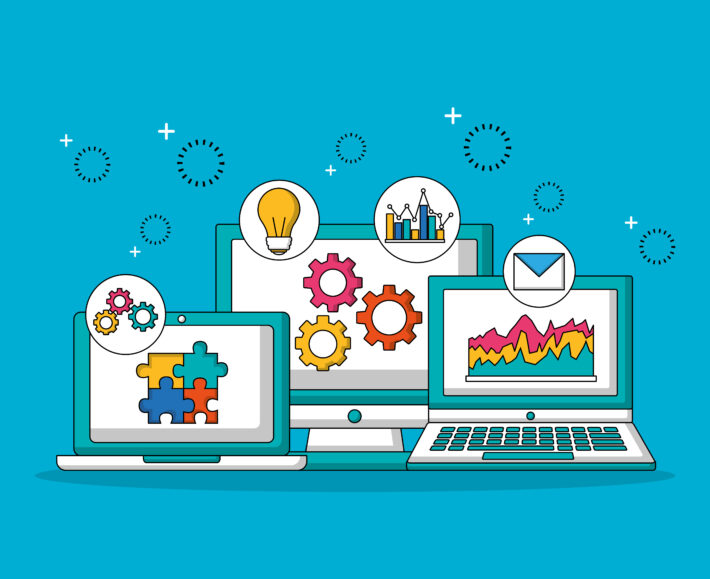Buying Software: Essential Tips for Evaluating and Selecting Software

Buying software is one of the most critical investments a business can make. With the right tools, companies can propel growth, efficiency, and innovation to new heights. But with endless options on the market, many organizations end up buying flashy software that fails to solve real business problems, wasting precious budgets on short-lived technology.
So how can you cut through the hype when buying software that truly delivers value? Follow our framework when navigating the software procurement process, and you’ll invest wisely in tools that move the needle towards goals – not just false promises.
Ready to Buy? Not So Fast! Ask These Questions Before Choosing Software.
The abundance of cool new software sure seems exciting! But hold up before getting swept away in flashy demos from sales reps. You need to do your homework first before making this big purchase.
Buying Software: Why is software evaluation important?
When buying software, evaluation is important because it allows you to thoroughly test if the software meets your needs and requirements before committing to a purchase or subscription. It saves you from wasted money and frustration. In the course of buying software, failing to evaluate is equivalent to planning to fail!
How do you Evaluate a Software before buying it?
When buying a new software solution, it’s important to thoroughly evaluate all options to ensure the product will meet your needs.
- Understand your needs. Make a list of the key features and functionality you require. This will help you determine if a software truly fits your needs.
- Check compatibility. Make sure the software works on your devices and operating systems. Also check if it integrates with other software you use.
- Try before you buy. Most vendors offer free trials, demos or free versions with limited features. Test drive the software yourself to see if it is easy to use and meets your needs.
- Read reviews. Go online to check what current users and experts are saying about the software. Look for reviews on independent websites to avoid biased opinions.
- Compare pricing. Research how the software is licensed (perpetual, subscription, etc.) and compare pricing models. Watch out for hidden costs. Consider the total cost of ownership over 3-5 years.
- Check vendor reputation. Research the software vendor, years in business, clientele, and accessibility of customer support. This gives you a sense of their reliability and capability.
- Assess ease of use. The software should have an intuitive user interface and documentation/resources that make it easy to onboard and use. If it is overly complex, it can reduce user adoption.
- Consider scalability. Evaluate if the software can adapt to your changing needs and scale up as your business grows in terms of users and functionality.
Following these tips will help you thoroughly assess and select the right software for your needs!
Key Features to Look for in the Software Procurement Process:
| Features |
| Compatible with current tech stack |
| Intuitive, easy-to-use interface |
| Scales to meet future needs |
| Strong security and permissions |
| Integration with other software |
| Mobile app availability |
| Customer support responsiveness |
| Total cost of ownership |
| Trial or demo available |
| Positive reviews from users |
| Meets industry standards |
| Offline accessibility |
| Customizability/workflows |
| Role-based permissions |
| API & extensibility |
| Import/export capabilities |
| Self-service reporting |
| Contract flexibility |
| Implementation & training |
| Access & device controls |
| Compliance certification |
| Performance & scalability |
| Guaranteed uptime |
| Data backup & recovery |
What Questions should you Ask Software Vendors before buying software?
Software vendors should provide detailed answers on Integration capabilities, customization options, implementation plans, training and support services, data migration tools, total cost projections, and security standards.
Here are some key questions you should ask software vendors before making a purchase:
- How long have you been in business? An established vendor with years of experience usually indicates stability in the market.
- How many clients do you have using this software? Ask for references you can talk to. This can give insight into their capabilities.
- Does your software integrate with other tools we use? See if it works with software you already use to avoid switching costs.
- What training resources do you offer? Make sure sufficient onboarding and ongoing enablement resources are available.
- How often is the software updated? Ask about their product development cycle for enhancements and feature upgrades.
- What level of ongoing support is included? Find out if they offer email, phone, chat, and online self-help and what the expected response times are.
- What is your uptime guarantee? Check if they offer an SLA for reliable software availability and performance.
- Can we get a custom-branded version of the software? See if you can get one aligned to your business identity and needs.
- Are there any consulting and configuration services? Find out if customization help is provided during and after onboarding.
- What third-party integrations do you support? See what other complementary solutions like payments, payroll, etc. integrate with it.
Asking these questions upfront ensures you select the right vendor tailored to your needs, capabilities, and service requirements.
How do you Create a Buying Software Requirements Checklist?
Download the Excel sheet to find the perfectly crafted software requirements checklist:
What is the Best Way to Negotiate Software Pricing and Contracts?
Here are some effective tips for negotiating software pricing and contracts:
- Do your homework. Research the typical price range for the software and maintain realistic expectations. Consider getting quotes from multiple vendors.
- Leverage competition. Let vendors know you are evaluating other options. Healthy competition can lead to better offers.
- Ask about nonprofit/volume discounts. See if they offer discounted pricing for startups, nonprofits, or bulk purchases.
- Push for a free trial. Don’t commit long-term until you’ve vetted the software. Negotiate free or low-cost trials of 1-3 months so you can evaluate the product in your own environment.
- Bundle products/services. Try to bundle software purchases with services like training, support, customized modules, etc. for better overall value.
- Request multiyear contracts. Multiyear commitments may offer substantially lower pricing compared to annual renewals.
- Link payment terms to milestones. This transfers some commercial risk to the vendor based on the delivery of functionality vs rigid payment schedules.
- Negotiate contract termination and liability clauses to cap your risks in case things don’t work out as expected after purchase.
- Get promises in writing, including pricing commitments, service levels, response times, capacities, etc. to avoid future conflicts.
The negotiation leverage depends on your purchase volumes and the length of contract. Use that to get the best possible deal. Maintain positive vendor relationships even during negotiations.
What Risks Should You Evaluate Before Choosing New Software?
- Security risk – Assess how secure the software and vendor are. Key things to review are encryption levels, vulnerability testing, authentication protocols, and the vendor’s historical security record. You want to minimize the risk of a data breach or cyberattack.
- Integration risk – Evaluate how well the new software will integrate with your existing IT systems and infrastructure. Poor integration can lead to data silos, workflow disruptions, and additional costs.
- Reliability risk – Research the software’s uptime history and backup provisions to assess reliability. Maximum reliability is crucial for mission-critical systems.
- Compliance risk – Determine if the software meets regulatory compliance requirements for your industry. Non-compliance can lead to legal jeopardy and fines.
- Vendor risk – Assess factors such as the vendor’s financial standing, operational history, reputation, and commitment to continued support. You don’t want to be left stranded.
- Usability risk – Test the software to evaluate its ease of use, navigation, and training demands on your staff. Overly complex software leads to reduced adoption and workflow inefficiencies.
Conducting thorough due diligence across these risk areas makes it safer to onboard new software that your users will adopt and that aligns with your organizational needs and priorities.
Who should be involved in the Software Evaluation Process?
Typically, several key stakeholders should be involved in evaluating potential software purchases for an organization:
- IT/Technology Team – IT leaders and staff play a critical role, as they understand the technical infrastructure and requirements for new software. They can evaluate integration needs, security considerations, hardware/bandwidth demands, and more.
- Business Unit Leaders – Managers and leaders from departments that will use the software provide key input on features, capabilities, and workflows that must be supported to meet business objectives.
- Finance/Procurement – Finance and procurement representatives ensure budgets are constructed properly, analyze cost factors like licensing and subscriptions, and negotiate favorable contractual terms with vendors.
- Operations – Those involved in core business operations assess how easy or difficult proposed systems will be to learn and use on a daily basis. They evaluate impacts on productivity.
- Administrative Roles – HR, legal, compliance and administrative roles evaluate a solution’s ability to meet policy, regulatory and reporting requirements.
- Key End Users – Select employees that will frequently use the system are commonly brought in to demo proposed tools. Their user perspective on usability and adoption is invaluable.
- Executive Sponsor – Gaining buy-in and budget from an executive sponsor will be essential to move forward with a software purchase and implementation plan.
Bringing together stakeholders across functions ensures all major considerations are explored in choosing new business software capabilities.
Last but not least, Confirm Demos Are Aligned With Contracts!
It is critical that software demonstrations accurately reflect what clients will receive based on the contracts they ultimately sign. Unfortunately, mismatches frequently occur – clients may see newer versions in demos but be bound to older releases or view key third-party integrations that get excluded from final agreements.
Rushing to close deals based on pressured timelines or discounts often exacerbates these issues. Clients must carefully scrutinize contracts to ensure they align with functionality in previous demos. Taking the necessary time in this process is essential to avoid major implementation failures down the road due to unmet expectations. This due diligence upfront will prevent costly surprises after signing.




